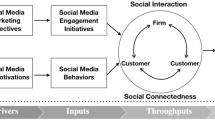Abstract
As an influence of social media service (SMS) is extending enormously and SMS becomes an important marketing way and a field of modern industry beyond a method to transfer informations. Under these circumstances that the influence of SMS is getting bigger bigger, which factors make users participate and work in the social media service and how relatively important these factors are between them need to be examined. But SMS are different from the existing information systems. Most information systems are task-oriented, that is, the systems aim to provide users with useful information for better decision making. Therefore, a different approach is required. In this research, we examine and select the main factors which affect users’ social media service use, and evaluate relative importance degrees of each factor on the basis of relationships between the factors with Analytic Network Process (ANP).




Similar content being viewed by others
References
Agarwal R, Karahanna E (2000) Time flies when you’re having fun: cognitive absorption and beliefs about information technology usage. MIS Q 24:665–694
Agarwal R, Prasad J (1999) Are individual differences germane to the acceptance of new information technologies? Decis Sci 30:361–391
Ashtona MC, Paunonena SV, Helmesa E, Jacksona DN (1988) Kin altruism, reciprocal altruism, and the big five personality factors. Evol Hum Behav 19(4):243–255
Bard JF, Sousk SF (1990) A tradeoff analysis for rough terrain cargo handlers using the AHP: an example of group decision-making. Eng Manag IEEE Trans 37(3):222–227
Cle’ment R, Noels K, Doeneault B (2001) Interethnic contact, identity, and psychological adjustments in the mediating and moderating roles of communication. J Soc Issues 57:559–578
Davis F (1989) Perceived usefulness, perceived ease of use, and user acceptance of information technology. MIS Q 13:319–340
Erickson T (2002) Some problems with the notion of context-aware computing. Commun ACM 45:102–104
Evans D (2008) Social media marketing: An hour a day. Wiley Publisher, Indianapolis
Gallego D, Huecas G (2012) An empirical case of a context-aware mobile recommender system in a banking environment. J Converg 3(4):41–48
Heitzmann CA, Kaplan RM (1988) Assessment of methods for measuring social support. Health Psychol 7(1):75–109
Hyde KM, Maier HR, Colby CB (2003) Incorporating Uncertainty in the PROMETHEE MCDA Method. J Multi-Criteria Decis Anal 12:245–259
Kailiponi P (2010) Analyzing evacuation decisions using multi-attribute utility theory (MAUT). Procedia Eng 3:163–174
Kim T, Biocca F (2004) Telepresence via television: Two dimensions of telepresence may have different connections to memory and persuasion J Computer-Mediated Commun 3(2)
Kwon O (2004) Modeling and generating context-aware agent-based applications with amended colored petri-nets. Expert Syst Appl 27:609–621
Kwon O, Wen Y (2010) An empirical study of the factors affecting social network service use. Comput Hum Behav 26:254–263
McDowell M, Morda D (2011) Socializing Securely: Using Social Networking Services, Carnegie Mellon University (Produced for US-CERT)
Oommen BJ, Yazidi A, Granmo O-C (2012) An adaptive approach to learning the preferences of users in a social network using weak estimators. J Inf Process Syst 8(No. 2):191–212
Rachung Y, Tzeng G-H (2006) A soft computing method for multi-criteria decision making with dependence and feedback. Appl Math Comput 180(6):63–75
Rau PP, Gao Q, Ding Y (2008) Relationship between the level of intimacy and lurking in online social network services. Comput Hum Behav 24(6):2757–2770
Riedlinger ME, Gallois C, Mckay S, Pittam J (2004) Impact of social group processes and functional diversity on communication in networked organizations. J Appl Commun Res 32(1):55–79
Saaty TL (1980) The analytic hierarchy process. McGraw-Hill, New York
Saaty TL (1996) Decision making with dependence and feedback: The analytic network process. RWS Publications, Pittsburgh
Saaty TL (2001) Decision making with dependence feedback: The analytic network process. RWS Publications, Pittsburgh
See Siew S, Khalil Md N, Al-Agaga AM (2012) Factors Affecting Malaysian young consumers’ online purchase intention in social media websites. Procedia - Soc Behav Sci 40:326–333
Tang X, Feng J (2006) ANP theory and application expectation. Stat Decis Mak 12(3):138–140
Turban E, King D, Lang J (2009) Introduction to electronic commerce. Pearson Education, Inc., Upper Saddle River
Venkatesh V (1999) Creation of favorable uses perceptions: exploring the role of intrinsic motivation. MIS Q 23:239–260
Venkatesh V, Morris M, Davis G, Davis F (2003) User acceptance of information technology: toward a unified view. MIS Q 27:425–478
Yanghoon K, Chang H (2012) IT convergence index and measurement design in the manufacturing industry. J Converg 3(3):47–50
Zhu Y, Jin Q (2012) An adaptively emerging mechanism for context-aware service selections regulated by feedback distributions. Human-centric Comput Inf Sci 2:1–15
Acknowledgment
This research supported by the MSIP (Ministry of Science, ICT and Future Planning), Korea, under the ITRC (Information Technology Research Center) support program (NIPA-2013-H0301-13-4007) supervised by the NIPA (National IT Industry Promotion Agency).
Author information
Authors and Affiliations
Corresponding author
Rights and permissions
About this article
Cite this article
Choi, CR., Jeong, HY., Park, J.H. et al. Relative weight evaluation of the factors inducing social media service use. Multimed Tools Appl 74, 5041–5054 (2015). https://doi.org/10.1007/s11042-013-1713-4
Published:
Issue Date:
DOI: https://doi.org/10.1007/s11042-013-1713-4




